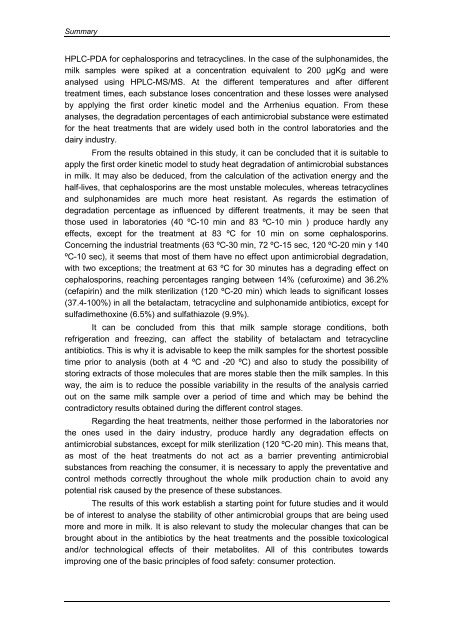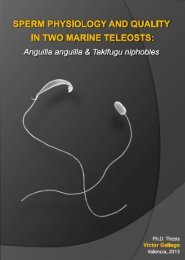termoestabilidad de sustancias antimicrobianas en la leche - RiuNet
termoestabilidad de sustancias antimicrobianas en la leche - RiuNet
termoestabilidad de sustancias antimicrobianas en la leche - RiuNet
You also want an ePaper? Increase the reach of your titles
YUMPU automatically turns print PDFs into web optimized ePapers that Google loves.
Summary<br />
HPLC-PDA for cephalosporins and tetracyclines. In the case of the sulphonami<strong>de</strong>s, the<br />
milk samples were spiked at a conc<strong>en</strong>tration equival<strong>en</strong>t to 200 µgKg and were<br />
analysed using HPLC-MS/MS. At the differ<strong>en</strong>t temperatures and after differ<strong>en</strong>t<br />
treatm<strong>en</strong>t times, each substance loses conc<strong>en</strong>tration and these losses were analysed<br />
by applying the first or<strong>de</strong>r kinetic mo<strong>de</strong>l and the Arrh<strong>en</strong>ius equation. From these<br />
analyses, the <strong>de</strong>gradation perc<strong>en</strong>tages of each antimicrobial substance were estimated<br />
for the heat treatm<strong>en</strong>ts that are wi<strong>de</strong>ly used both in the control <strong>la</strong>boratories and the<br />
dairy industry.<br />
From the results obtained in this study, it can be conclu<strong>de</strong>d that it is suitable to<br />
apply the first or<strong>de</strong>r kinetic mo<strong>de</strong>l to study heat <strong>de</strong>gradation of antimicrobial substances<br />
in milk. It may also be <strong>de</strong>duced, from the calcu<strong>la</strong>tion of the activation <strong>en</strong>ergy and the<br />
half-lives, that cephalosporins are the most unstable molecules, whereas tetracyclines<br />
and sulphonami<strong>de</strong>s are much more heat resistant. As regards the estimation of<br />
<strong>de</strong>gradation perc<strong>en</strong>tage as influ<strong>en</strong>ced by differ<strong>en</strong>t treatm<strong>en</strong>ts, it may be se<strong>en</strong> that<br />
those used in <strong>la</strong>boratories (40 ºC-10 min and 83 ºC-10 min ) produce hardly any<br />
effects, except for the treatm<strong>en</strong>t at 83 ºC for 10 min on some cephalosporins.<br />
Concerning the industrial treatm<strong>en</strong>ts (63 ºC-30 min, 72 ºC-15 sec, 120 ºC-20 min y 140<br />
ºC-10 sec), it seems that most of them have no effect upon antimicrobial <strong>de</strong>gradation,<br />
with two exceptions; the treatm<strong>en</strong>t at 63 ºC for 30 minutes has a <strong>de</strong>grading effect on<br />
cephalosporins, reaching perc<strong>en</strong>tages ranging betwe<strong>en</strong> 14% (cefuroxime) and 36.2%<br />
(cefapirin) and the milk sterilization (120 ºC-20 min) which leads to significant losses<br />
(37.4-100%) in all the beta<strong>la</strong>ctam, tetracycline and sulphonami<strong>de</strong> antibiotics, except for<br />
sulfadimethoxine (6.5%) and sulfathiazole (9.9%).<br />
It can be conclu<strong>de</strong>d from this that milk sample storage conditions, both<br />
refrigeration and freezing, can affect the stability of beta<strong>la</strong>ctam and tetracycline<br />
antibiotics. This is why it is advisable to keep the milk samples for the shortest possible<br />
time prior to analysis (both at 4 ºC and -20 ºC) and also to study the possibility of<br />
storing extracts of those molecules that are mores stable th<strong>en</strong> the milk samples. In this<br />
way, the aim is to reduce the possible variability in the results of the analysis carried<br />
out on the same milk sample over a period of time and which may be behind the<br />
contradictory results obtained during the differ<strong>en</strong>t control stages.<br />
Regarding the heat treatm<strong>en</strong>ts, neither those performed in the <strong>la</strong>boratories nor<br />
the ones used in the dairy industry, produce hardly any <strong>de</strong>gradation effects on<br />
antimicrobial substances, except for milk sterilization (120 ºC-20 min). This means that,<br />
as most of the heat treatm<strong>en</strong>ts do not act as a barrier prev<strong>en</strong>ting antimicrobial<br />
substances from reaching the consumer, it is necessary to apply the prev<strong>en</strong>tative and<br />
control methods correctly throughout the whole milk production chain to avoid any<br />
pot<strong>en</strong>tial risk caused by the pres<strong>en</strong>ce of these substances.<br />
The results of this work establish a starting point for future studies and it would<br />
be of interest to analyse the stability of other antimicrobial groups that are being used<br />
more and more in milk. It is also relevant to study the molecu<strong>la</strong>r changes that can be<br />
brought about in the antibiotics by the heat treatm<strong>en</strong>ts and the possible toxicological<br />
and/or technological effects of their metabolites. All of this contributes towards<br />
improving one of the basic principles of food safety: consumer protection.

















